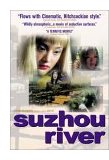

|
| weblog/wEssays | home | |
|
Suzhou River (October 11, 2005)  First, some geography. Suzhou River runs from the city of Suzhou (which I have visited several times) down through Shanghai (which I have also visited several times), where it forms the north border of the city's old commercial hub, the Bund. The opening sequence of the film is a strikingly accurate montage of Shanghai river life: filty water, lined with decaying old buildings in places, and peopled by poor boat and barge operators who live in small quarters on their rivercraft. This is the China not of glossy chic stores but of the gritty realities of industrialization and large-scale poverty. Stylistically, the film employs "new cinema" techniques such as hand-held cameras and saturated reds and greens reminiscient of Wong Kar-Wai's use of color and composition. The movie is categorized, for lack of a better label, as "noir," as the grittiness, sleazy night life and depiction of low-life criminals harkens back to the film noir popular in the 1950s. The core of the movie, however, is a well-used plot gimmick most famously explored by the Hitchcock classic "Vertigo": a question of identity. This is not to say that such derivative plots are bad--it's just that the treatment has to be fresh or we end up feeling that we've seen the film before. On top of this basic plot--is this beautiful young woman the girl who the bike messenger betrayed years before?--is layered another cinematic technique: the POV (point of view), in which the film is narrated by a low-end video producer. Indeed, we never see him, as the camera angle is POV throughout, e.g. we see what he sees, as if his eyes were the camera. The narrator tells his own tale of meeting and falling into a relationship with the gorgeous young woman (Xun Zhou) who performs as a mermaid in a neon-lit bar for a living, and then introduces the story of the motorbike messenger and his doomed relationship with a teenaged girl who has a crush on him. For reasons which are left murky (shall we just call it slapdash?), the messenger gets involved in a kidnap/ransom scheme in which he kidnaps the girl. Once freed, she jumps into the Suzhou River and promptly disappears. At this point, he turns the narration over to Mardar, the messenger, and retreats until the final reel in which he has Mardar beaten up as a rival for the affection of the beautiful young woman. Confused yet? The problem with the film isn't the complicated narrative and POV--it's that we don't believe the characters are real. They are players in a noir fairy tale of sorts, perhaps, but not real people with emotions we can grasp. Indeed, the lead actors and actress are expressionless. Why did Mardar betray the girl who loved him? Did he have no other choice? It seems he had plenty of other options: escape with her, betray the crooks, etc. So having betrayed her, he seeks redemption through finding her again. But then when he apparently does find her, the couple is found dead in the Suzhou River: accident or suicide, we have no clue, but again it seems like a contrivance rather than something integral to the characters. Equally improbably, we're told the beautiful woman leaves the narrator for days on end without explanation, and though this "drives him crazy," he never asks her about it, follows her, etc. The characters are strangely detached from real-life motivations, desires, and emotions. As a result, we are left with a certain dissatisfaction with characters whose internal traits and experiences do not seem consistent or "real." Contrast this with the characters in "Blue," who are at a minimum consistent with what we've been shown, and consistent with emotions and reactions we can understand. Though "Suzhou River" is a visually compelling movie, with first-rate cinematography and technique, a noir assembly does not a character or film make. * * * copyright © 2005 Charles Hugh Smith. All rights reserved in all media. I would be honored if you linked this wEssay to your site, or printed a copy for your own use. * * * |
||
| weblog/wEssays | home |